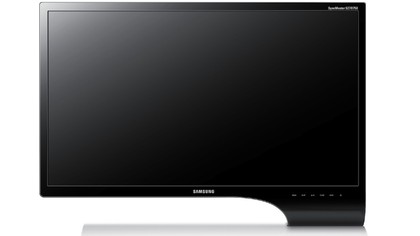TechRadar Verdict
Pros
- +
Stunning chassis and stand
- +
Good image quality
- +
Smartphone mirroring
- +
Decent sound
- +
Lots of OSD options
Cons
- -
TN panel not as good as IPS
- -
Stand is tilt-only
- -
Some settings fiddly to access
- -
No DVI or DisplayPort
- -
Some prefer 16:10 to 16:9
Why you can trust TechRadar
After several stagnant years in PC display tech, things have been really hotting up recently with much improved LCD panel quality and lower prices. The latest warrior to enter this busy battlefield is the Samsung SyncMaster S24B750V LED monitor.
It's part of Samsung's Design range of screens, and that means cutting a dash on your desktop is probably as important as serving up quality visuals. But that doesn't mean the Samsung Series 7 S24B750V LED monitor - priced at £250 - is all show and no go.
In fact, it sports a number of intriguing new technology as well as further more familiar but nevertheless welcome features. First up is Mobile High-Definition Link (MHL). We'll get to the details momentarily, but the basic idea is outputting an image directly from a high-end smartphone.
An LED backlight also bodes well for both image quality and power efficiency. Decent quality integrated audio is another part of the Samsung S24B750V's particular remit. Very few PC monitors can claim much prowess in that department.
However, what it doesn't get is a high quality PCD panel. At least, the underlying technology used is TN, which is the cheapest and typically poorest performing of the commonly used LCD types. Samsung itself tends to use either PVA or its new PLS tech, the latter being Samsung's take on the high performance IPS panels seen in the latest tablets and smartphones.
Problem is, IPS has also begun to pop up in affordable PC monitors. The AOC i2352Vh, for instance, can be had for just £130 or $200. OK, the AOC is only 23 inches, not 24 like the Samsung 7 S24B750V LED monitor, and its chassis and enclosure is cheap and cheerful at best.
But it offers the same 1,920 x 1,080 full-HD native resolution and a quality IPS panel for a lot less money.
Sign up for breaking news, reviews, opinion, top tech deals, and more.
On the other hand, the Dell U2412M very much is 24 inches and even higher resolution and it's yours for around £225 or $310. Samsung has its work cut out, that's for sure.
Specifications
If the Samsung SyncMaster S24B750V LED monitor is going to have a problem, it'll be its LCD panel. It's a TN panel and that normally means substandard colours, contrast, black tones, viewing angles and more.
Some evidence of that can be seen in the basic specifications, particularly the relatively narrow 170 and 160-degree horizontal and vertical viewing angles. IPS panels are usually rated at 178 degrees in both planes. To be honest, even that doesn't capture the dramatic difference in view angle capability between TN and IPS technology.
The same goes for the rest of the image quality specifications. The 250cd/m2 brightness and 1,000:1 contrast don't reveal much. That said, 2ms response bode well for games and motion video.
The LED backlight might help compensate for the pedestrian panel technology. At the very least, it will reduce power consumption and ensure a long operating life. Old school CCFL backlights tend to lose their visual pop more rapidly than LED.
Resolution-wise, we're talking Full HD or 1,920 x 1,080 pixels and therefore an HD TV-aping 16:9 aspect ratio. That's pretty much par for the course for affordable PC monitors these days. However, there are a few exceptions - including the Dell U2412M - that stick with 16:10 and therefore offer 1,200 vertical pixels. For PCs, we think that's more useful.
As for video inputs, you get a pair of HDMI ports and a VGA connection. In theory, that's just fine since nearly all modern PC graphics cards are compatible with HDMI. In practice you may find AMD video cards give problems. NVIDIA and integrated Intel graphics are almost always fine.

Elsewhere, the Samsung Series 7 S24B750V LED monitor is a bit of a mixed bag. There's absolutely no doubting the swoopy, asymmetric stand and chassis look absolutely stunning. If we were judging on looks alone, it would probably be the best screen we've ever seen.
The problem is, adjustability is sacrificed at the altar of showbiz looks. So, the stand is tilt-only.
Still, with any luck, that consumer electronics vibe will translate into decent sound quality. The 5W, two channel audio setup isn't exactly tub-thumping on paper. But it doesn't need to be to beat almost every PC monitor out there for sound quality and volume.
Arguably even more novel is the MHL (Mobile High-Definition Link) feature. With compatible smartphones (quite a few current Samsung models, such as the Galaxy S2, and other brand handsets), you can hook up via HDMI and mirror the handset's interface in full, both in portrait and landscape modes, across the full 24 inches of screen.
Technology and cars. Increasingly the twain shall meet. Which is handy, because Jeremy (Twitter) is addicted to both. Long-time tech journalist, former editor of iCar magazine and incumbent car guru for T3 magazine, Jeremy reckons in-car technology is about to go thermonuclear. No, not exploding cars. That would be silly. And dangerous. But rather an explosive period of unprecedented innovation. Enjoy the ride.
